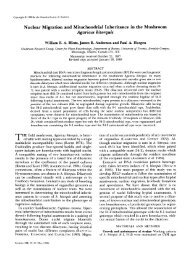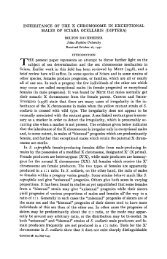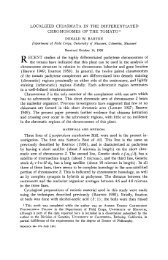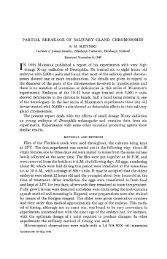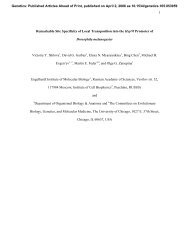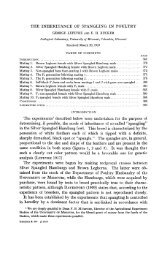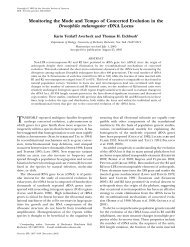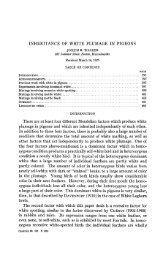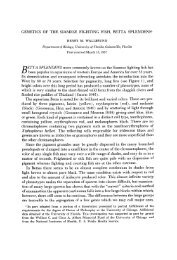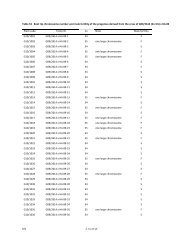abstracts of papers presented at the 1962 meetings - Genetics
abstracts of papers presented at the 1962 meetings - Genetics
abstracts of papers presented at the 1962 meetings - Genetics
Create successful ePaper yourself
Turn your PDF publications into a flip-book with our unique Google optimized e-Paper software.
ABSTRACTS 967<br />
dent maize inbred lines assayed both in 1960 and 1961. All assays were made on field-grown<br />
plants. With only one exception, rel<strong>at</strong>ive levels <strong>of</strong> NR activity were similar within this set <strong>of</strong><br />
lines in <strong>the</strong> two years, <strong>the</strong> between-years correl<strong>at</strong>ion being highly significant. F, hybrids showed<br />
NR activity levels generally intermedi<strong>at</strong>e between those <strong>of</strong> <strong>the</strong> respective parental lines. Different<br />
inbred lines showed widely dissimilar seasonal p<strong>at</strong>terns <strong>of</strong> NR activity levels. Generally, <strong>the</strong><br />
inheritance <strong>of</strong> <strong>the</strong> control <strong>of</strong> NR activity level appears to be complex; no indic<strong>at</strong>ions <strong>of</strong> “single<br />
gene control” or “nitr<strong>at</strong>e-reductase-less” mutant forms have been found. Since this enzyme has<br />
been shown to play an important role in <strong>the</strong> nitrogen metabolic cycle <strong>of</strong> <strong>the</strong> maize plant, it ap-<br />
pears likely th<strong>at</strong> hereditary differences in NR activity could be important in <strong>the</strong> determin<strong>at</strong>ion <strong>of</strong><br />
yield levels. Fur<strong>the</strong>r studies are in progress.<br />
LEVINTHAL, MARK, S. FOGEL, and D. D. HURST, Brooklyn College, Brooklyn, N.Y.: Genetic<br />
and biochemical analysis <strong>of</strong> purine biosyn<strong>the</strong>tic p<strong>at</strong>hways in Saccharomyces.-Nine separ<strong>at</strong>e<br />
genetic blocks <strong>of</strong> adenine syn<strong>the</strong>sis are known in yeast. On completely specified media all mutants<br />
produce white clones with <strong>the</strong> exception <strong>of</strong> ad-1 and ad-2. These produce a red, pink, or<br />
buff pigment th<strong>at</strong> is influenced by o<strong>the</strong>r loci, especially those affecting methionine, threonine or<br />
histidine syn<strong>the</strong>sis. Doubly blocked stocks containing ad-1 or ad-2 fail to accumul<strong>at</strong>e pigment.<br />
Extracts <strong>of</strong> all single mutants, ad-1 through ad-8, have been examined for <strong>the</strong> presence <strong>of</strong><br />
diazotizable amines via paper chrom<strong>at</strong>ography and <strong>the</strong> Br<strong>at</strong>ton-Marshall reaction. On <strong>the</strong> basis<br />
<strong>of</strong> <strong>the</strong> major product accumul<strong>at</strong>ed, <strong>the</strong> mutants fall into five classes as follows: ad-1-AIR; ad-2,<br />
CAIR; ad-3 and ad4, AICAR; ad-5, ad-6, and ad-7, SAICAR; add, no diazotizable amine<br />
found. The d<strong>at</strong>a indic<strong>at</strong>e a purine biosyn<strong>the</strong>sis p<strong>at</strong>hway consistent with th<strong>at</strong> <strong>of</strong> both pigeon<br />
liver, Neurospora, and microbial systems. Accumul<strong>at</strong>ion studies concerning multiply blocked<br />
stocks, suppressor action and effects <strong>of</strong> known genetic modifiers are in progress. (This work has<br />
been supported by NIH Grant #RG-6979.)<br />
LEWIS, H. W., and H. S. LEWIS, Michigan St<strong>at</strong>e University Oakland, Rochester, Mich.: Zdenti-<br />
fic<strong>at</strong>ion <strong>of</strong> a dominant second chromosome factor regul<strong>at</strong>ing dopa oxidase activity in Drosophila<br />
me1anogaster.-A dominant gene (beta) has been identified on chromosome I1 which accounts<br />
in large measure for <strong>the</strong> low dopa oxidase activity in 20-3, a line selected for low enzyme activity<br />
from a Samarkand strain. Crosses between <strong>the</strong> 10-3 strain and a marker strain (b cn bw) yield<br />
testcross classes whose activities in dopa oxidase units are as follows: b cn + bw/b cn + bw and<br />
b cn + +/b cn + bw, activities >1000; + + /3 +/b cn f bw and -?- + /3 bw/b cn + bw, activi-<br />
ties 1000. The hi-3 strain is <strong>the</strong>refore regarded as homozygous wild<br />
type <strong>at</strong> <strong>the</strong> /3 locus. In progeny tests <strong>of</strong> individuals representing crossovers between b and cn,<br />
b + individuals are associ<strong>at</strong>ed with /3 activity and all + cn individuals with non+ activity.<br />
These tests <strong>of</strong>fer evidence th<strong>at</strong> <strong>the</strong> /3 locus is several map units to <strong>the</strong> right <strong>of</strong> <strong>the</strong> put<strong>at</strong>ive struc-<br />
tural locus, Alpha.<br />
LIEB, M., University <strong>of</strong> Sou<strong>the</strong>rn California Medical School, Los Angeles, Calif.: Effect <strong>of</strong><br />
substances th<strong>at</strong> enhance UV mut<strong>at</strong>ion on UV induction and on photoreactiv<strong>at</strong>ion in lysogenic<br />
bacteria.-Methyl purines and acridine dyes will increase <strong>the</strong> frequency <strong>of</strong> mut<strong>at</strong>ion when<br />
UV-irradi<strong>at</strong>ed bacteria are grown in <strong>the</strong>ir presence. No mutants are induced in unirradi<strong>at</strong>ed<br />
bacteria under <strong>the</strong> same conditions. These substances have much less effect on bacterial killing.<br />
It has been proposed th<strong>at</strong> <strong>the</strong> LJV-enhancing substances prevent a “dark reactiv<strong>at</strong>ion” process<br />
th<strong>at</strong> repairs certain UV-induced lesions, presumably in DNA.-We have studied <strong>the</strong> effect <strong>of</strong><br />
post-UV tre<strong>at</strong>ment with caffein, acriflavin or pr<strong>of</strong>lavin on a nonlysogenic straih <strong>of</strong> E. coli K-12<br />
and on lambda-lysogenic deriv<strong>at</strong>ives. Killing <strong>of</strong> lysogenic strains was increased 5-1OX under<br />
conditions which increased killing <strong>of</strong> nonlysogenic strains only slightly. UV-survival curves <strong>of</strong>





